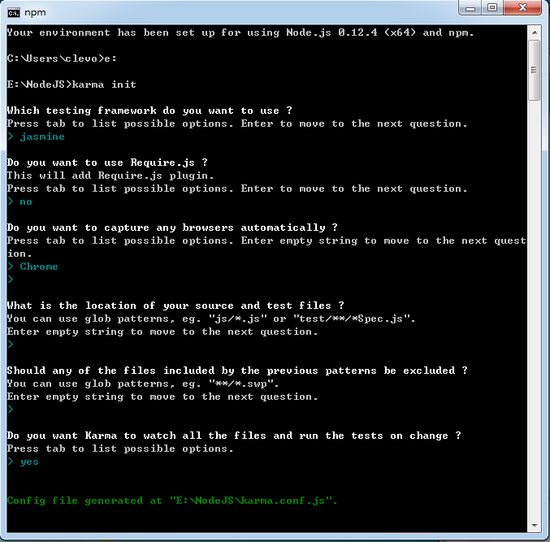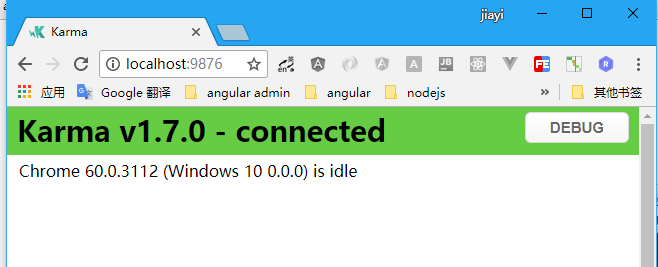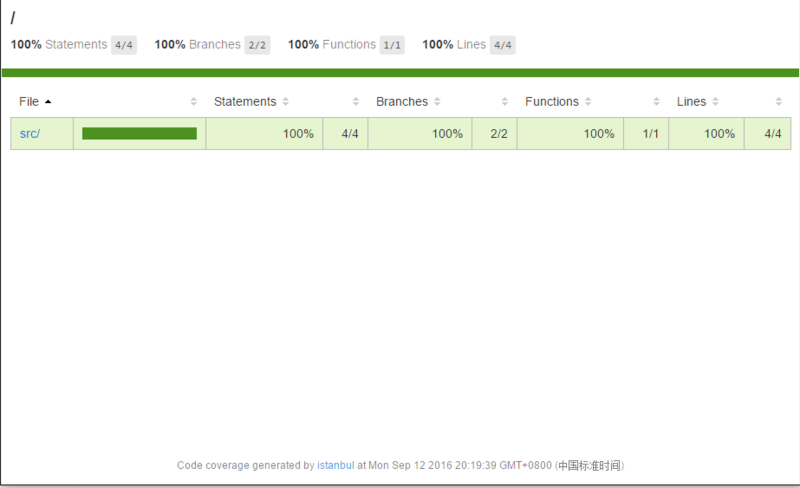学习Karma+Jasmine+istanbul+webpack自动化单元测试
2018-02-08 23:44 龙恩0707 阅读(2184) 评论(0) 收藏 举报学习Karma+Jasmine+istanbul+webpack自动化单元测试
1-1. 什么是karma?
Karma 是一个基于Node.js的Javascript测试执行过程管理工具。该工具可用于测试所有主流web浏览器,也可集成到CI工具,也可以
和其他代码编辑器一起使用,它可以监听文件的变化,然后自动执行。
1-2. 什么是Jasmine?
Jasmine也是一款javascript测试框架。Jasmine官网文档地址(https://jasmine.github.io/2.3/introduction.html)
1-3. 什么是istanbul?
istanbul 是一个单元测试代码覆盖率检查工具,它可以直观的告诉我们,单元测试对代码的控制程度。
2. 安装Karma环境
如下命令:
npm install -g karma
为了方便搭建karma环境,我们可以全局安装karma-cli来帮我们初始化测试环境。
如下命令安装:
npm install -g karma-cli
我们在项目的根目录下也需要安装一下,如下命令:
npm install karma --save-dev
如上,安装完成以后,我们在项目的根目录下的命令行输入命令:karma start
运行如下:
karma start 08 02 2018 21:38:49.566:WARN [karma]: No captured browser, open http://localhost:9876/ 08 02 2018 21:38:49.572:INFO [karma]: Front-end scripts not present. Compiling... 08 02 2018 21:38:50.257:INFO [karma]: Karma v2.0.0 server started at http://0.0.0.0:9876/
然后我们在浏览器输入 http://localhost:9876, 如下图所示:

如果出现以上信息,表示karma已经安装成功了。
3. karma的配置
命令如下:
karma init

对上面命令的说明如下:
1. 使用哪个测试框架,我们选择了jasmine
2. 是否添加Require.js插件,我们选择no,不添加。
3. 选择浏览器,我们选择了chrome。
4. 测试文件路径设置,文件可以使用通配符匹配,比如*.js匹配指定目录下所有的js文件。
5. 在测试文件路径下,需要被排除的文件。
6. 是否允许karma监测文件,yes表示当测试文件变化时候,karma会自动测试。
如上命令后,就会在项目的根目录下 生成 karma.conf.js 文件;
下面对常用的 karma.conf.js 配置项进行解析说明如下:
// Karma configuration // Generated on Thu Feb 08 2018 10:39:50 GMT+0800 (CST) module.exports = function(config) { config.set({ // 将用于解析所有模式的基本路径 basePath: '', // 选择测试框架,我们选择 'jasmine' // available frameworks: https://npmjs.org/browse/keyword/karma-adapter frameworks: ['jasmine'], // 在浏览器中加载的匹配的文件列表。 files: [ /* 注意:是自己添加的 */ 'src/**/*.js', 'test/**/*.js' ], // 要排除的文件列表 exclude: [],// 在将其提供给浏览器之前,预处理匹配的文件, // available preprocessors: https://npmjs.org/browse/keyword/karma-preprocessor preprocessors: { },// 怎么显示测试结果 // 测试结果显示插件: https://npmjs.org/browse/keyword/karma-reporter reporters: ['progress'], // 服务器的端口号 port: 9876, // 在输出中启用/禁用颜色(记录reporters和日志), colors: true, // 显示日志记录的级别(默认就好) // possible values: config.LOG_DISABLE || config.LOG_ERROR || config.LOG_WARN || config.LOG_INFO || config.LOG_DEBUG logLevel: config.LOG_INFO, // 当任何测试文件更改时候,启用/禁用监听文件并执行测试 autoWatch: true, // start these browsers 启动的浏览器chrome // available browser launchers: https://npmjs.org/browse/keyword/karma-launcher browsers: ['Chrome'], // 持续集成模式,默认就好 // if true, Karma captures browsers, runs the tests and exits singleRun: false, // 并发级别,可以同时启动多少个浏览器,默认无限大 // how many browser should be started simultaneous concurrency: Infinity }) }
如上代码中的 config.set 中的 files 配置的 是我自己添加的;如下代码:
files: [ /* 注意:是自己添加的 */ 'src/**/*.js', 'test/**/*.js' ]
它的作用是:就是把需要测试的文件都require进来,然后一股脑的在browsers里面跑。
4. 开启Karma
命令如下: karma start
手动打开chrome,输入localhost:9876 即可打开了。
在控制台命令行中看到如下信息 说明运行成功了。
~/个人demo/vue1204/karma-demo on Dev_20171115_wealth! $ karma start 08 02 2018 11:06:41.365:WARN [karma]: No captured browser, open http://localhost:9876/ 08 02 2018 11:06:41.379:INFO [karma]: Karma v2.0.0 server started at http://0.0.0.0:9876/ 08 02 2018 11:06:41.380:INFO [launcher]: Launching browser Chrome with unlimited concurrency 08 02 2018 11:06:41.386:INFO [launcher]: Starting browser Chrome 08 02 2018 11:06:42.457:INFO [Chrome 64.0.3282 (Mac OS X 10.11.6)]: Connected on socket JUZvceJFJhGgWFYJAAAA with id 7542403 LOG: 111 Chrome 64.0.3282 (Mac OS X 10.11.6): Executed 1 of 1 SUCCESS (0.011 secs / 0 secs)
运行后会自动打开chrome浏览器,http://localhost:9876/?id=50037613

先来安装一下依赖的插件如下:
1. 需要可以打开chrome浏览器的插件 npm install karma-chrome-launcher --save-dev
2. 需要可以运行jasmine的插件 npm install karma-jasmine jasmine-core --save-dev
3. 需要可以运行webpack的插件 npm install karma-webpack webpack --save-dev
4. 需要可以显示的sourcemap的插件 npm install karma-sourcemap-loader --save-dev
5. 需要可以显示测试代码覆盖率的插件 npm install karma-coverage-istanbul-reporter --save-dev
6. 需要全局安装 jasmine-core 如命令:npm install -g jasmine-core
如下一键安装命令:
npm install --save-dev karma-chrome-launcher karma-jasmine karma-webpack karma-sourcemap-loader karma-coverage-istanbul-reporter
也需要全局安装一下 jasmine-core, 如下代码:
npm install -g jasmine-core
我们可以写一个简单的测试用例;如下目录结构:
karma-demo |---src | --index.js |--- test | |-- index.test.js | |--- karma.conf.js
src/index.js代码如下:
function isNum(num) { if (typeof num === 'number') { return true; } else { return false; } }
test/index.test.js代码如下:
describe('测试用例编写', function() {
it('isNum() should work fine', function() {
console.log(111)
expect(isNum(1)).toBe(true);
expect(isNum('1')).toBe(false);
});
});
如上代码我们可以看到 在 test/index.test.js 里面我们调用了 isNum方法,但是并没有使用require引用进来而可以使用,那是因为
我们的karma.conf.js里面的配置文件 files里面设置了,因此没有使用require就可以使用了。
files: [ /* 注意:是自己添加的 */ 'src/**/*.js', 'test/**/*.js' ]
它的作用是:就是把需要测试的文件都require进来,然后一股脑的在browsers里面跑。
5. Coverage
如何测量测试脚本的质量呢?其中有一个参考指标就是代码覆盖率。
5-1:什么是代码覆盖率?
代码覆盖率是在测试中运行到的代码占所有代码的比率。因此接下来我们在Karma环境中添加Coverage。
在项目的根目录下,运行如下命令进行安装
npm install --save-dev karma-coverage
然后需要在配置文件 karma.conf.js 代码配置如下:
module.exports = function(config) { config.set({ // base path that will be used to resolve all patterns (eg. files, exclude) basePath: '', // frameworks to use // available frameworks: https://npmjs.org/browse/keyword/karma-adapter frameworks: ['jasmine'], // list of files / patterns to load in the browser files: [ /* 注意:是自己添加的 */ 'src/**/*.js', 'test/**/*.js' ], // list of files / patterns to exclude exclude: [], // preprocess matching files before serving them to the browser // available preprocessors: https://npmjs.org/browse/keyword/karma-preprocessor /* 覆盖源文件 不包括测试库文件*/ preprocessors: { 'src/**/*.js': ['coverage'] }, // test results reporter to use // possible values: 'dots', 'progress' // available reporters: https://npmjs.org/browse/keyword/karma-reporter reporters: ['progress', 'coverage'], /* 新增的配置项 */ coverageReporter: { type: 'html', dir: 'coverage/' }, // web server port port: 9876, // enable / disable colors in the output (reporters and logs) colors: true, // level of logging // possible values: config.LOG_DISABLE || config.LOG_ERROR || config.LOG_WARN || config.LOG_INFO || config.LOG_DEBUG logLevel: config.LOG_INFO, // enable / disable watching file and executing tests whenever any file changes autoWatch: true, // start these browsers // available browser launchers: https://npmjs.org/browse/keyword/karma-launcher browsers: ['Chrome'], // Continuous Integration mode // if true, Karma captures browsers, runs the tests and exits singleRun: false, // Concurrency level // how many browser should be started simultaneous concurrency: Infinity }) }
具体的配置可以参考 https://www.npmjs.com/package/karma-coverage
再运行下 karma start后,会在根目录下生产 coverage目录,里面有index.html作为本次的测试报告,我们打开看下,如下:

如上代码的覆盖率是对源文件需要被测试的覆盖率是100%;
要生成代码覆盖率,可以看这篇文章(http://karma-runner.github.io/0.8/config/coverage.html)
想要生成覆盖率,需要在配置项配置如下三个选项:
1. preprocessors coverage (必须配置的)
2. reporters coverage (必须配置的)
3. reporter options (可选的)
1. Preprocessors(配置预处理器)
preprocessors 的含义是:是那些测试文件需要被覆盖,比如,如果所有代码都在src/下的文件 您需要添加到您的配置文件,如上
配置代码:
preprocessors: { 'src/**/*.js': ['coverage'] }
注意: 不要包含你所依赖的库,测试文件等等,下面就是一个错误的配置信息。
files = [ JASMINE, JASMINE_ADAPTER, 'lib/*.js', 'test/*.js' ]; preprocessors = { '**/*.js': 'coverage' };
2. Reporters(配置报告)
在配置文件中包含下面的信息来激活覆盖率报告器。
如上配置代码:
reporters: ['progress', 'coverage'],
这样将会对每个浏览器创建一个覆盖率报告,另外,它还会创建一个 Json 文件,其中包含输出的中间数据。
3. Reporter Options(配置报告选项)
默认的报告格式如下:
coverageReporter: { type: 'html', dir: 'coverage/' },
type 是一个字符串值,取值可以是:
html (default)
lcov (lcov and html)
lcovonly
text
text-summary
cobertura (xml format supported by Jenkins)
dir 则用来配置报告的输出目录。
如果类型是 text 或者 text-summary,你可以配置 file 参数来指定保存的文件名。
coverageReporter = { type : 'text', dir : 'coverage/', file : 'coverage.txt' }
如果没有文件名,就会输出到控制台。
6. webpack和Babel集成Karma环境中。
在项目中,会使用到webpack和es6,因此需要集成到karma环境中。
安装karma-webpack
npm install --save-dev karma-webpack webpack
1.安装babel核心文件 npm install babel-core --save-dev
2. webpack的Loader处理器 npm install babel-loader --save-dev
3. babel的istanbul覆盖率插件 npm install babel-plugin-istanbul --save-dev
4. babel转换到哪个版本这里是ES2015 npm install babel-preset-es2015 --save-dev
一键安装命令如下:
npm install --save-dev babel-loader babel-core babel-preset-es2015 babel-plugin-istanbul
然后 src/index.js 代码变成如下:
function isNum(num) { if (typeof num === 'number') { return true; } else { return false; } } module.exports = isNum;
test/index.test.js 变成如下:
const isNum = require('../src/index');
describe('测试webpack+babel集成到Karma中', () => {
it('isNum() should work fine.', () => {
expect(isNum(1)).toBe(true);
expect(isNum('1')).toBe(false);
})
});
接下来修改配置文件karma.conf.js 如下配置代码:
module.exports = function(config) { config.set({ // base path that will be used to resolve all patterns (eg. files, exclude) basePath: '', // frameworks to use // available frameworks: https://npmjs.org/browse/keyword/karma-adapter frameworks: ['jasmine'], // list of files / patterns to load in the browser files: [ /* 注意:是自己添加的 */ 'test/**/*.js' ], // list of files / patterns to exclude exclude: [], // preprocess matching files before serving them to the browser // available preprocessors: https://npmjs.org/browse/keyword/karma-preprocessor preprocessors: { 'test/**/*.js': ['webpack', 'coverage'] }, // test results reporter to use // possible values: 'dots', 'progress' // available reporters: https://npmjs.org/browse/keyword/karma-reporter reporters: ['progress', 'coverage'], /* 新增的配置项 */ coverageReporter: { type: 'html', dir: 'coverage/' }, // web server port port: 9876, // enable / disable colors in the output (reporters and logs) colors: true, // level of logging // possible values: config.LOG_DISABLE || config.LOG_ERROR || config.LOG_WARN || config.LOG_INFO || config.LOG_DEBUG logLevel: config.LOG_INFO, // enable / disable watching file and executing tests whenever any file changes autoWatch: true, // start these browsers // available browser launchers: https://npmjs.org/browse/keyword/karma-launcher browsers: ['Chrome'], // Continuous Integration mode // if true, Karma captures browsers, runs the tests and exits singleRun: false, // Concurrency level // how many browser should be started simultaneous concurrency: Infinity, webpack: { module: { loaders: [{ test: /\.js$/, loader: 'babel-loader', exclude: /node_modules/, query: { presets: ['es2015'] } }] } } }) }
如上代码修改的地方:
1. files只留下test文件。因为webpack会自动把需要的其它文件都打包进来,所以只需要留下入口文件。
2. preprocessors也修改为test文件,并加入webpack域处理器。
3. 加入webpack配置选项。可以自己定制配置项,但是不需要entry和output。这里加上babel-loader来编译ES6代码
命令行运行karma start,成功了~
但是我们再来看看 coverage/xx/index.html

如上图测试覆盖率 不是100%;
原因是webpack会加入一些代码,影响了代码的Coverage。如果我们引入了一些其它的库,比如jquery之类的,将源代码和库代码打包在一起后,覆盖率会更难看。
因此我们需要安装如下插件来解决上面的问题。
istanbul的介绍:
istanbul是一个单元测试代码覆盖率检查工具,可以很直观地告诉我们,单元测试对代码的控制程度。
1. webpack的Loader处理器 npm install istanbul-instrumenter-loader --save-dev
2. 测试覆盖率显示插件 npm install karma-coverage-istanbul-reporter --save-dev
然后我们去修改 karma.conf.js
webpack: { module: { rules: [ { test: /\.js$/, use: { loader: 'babel-loader', options: { presets: ['es2015'], plugins: ['istanbul'] } }, exclude: /node_modules/ } ] } }
先给babel加上插件 plugins: ['istanbul'];
再写上 istanbul-instrumenter-loader 的配置,所以整个配置的代码变成如下:
然后把 karma.conf.js 配置改成如下:
webpack: { module: { rules: [ { test: /\.js$/, use: { loader: 'istanbul-instrumenter-loader', options: { esModules: true } }, enforce: 'pre', exclude: /node_modules/ }, { test: /\.js$/, use: { loader: 'babel-loader', options: { presets: ['es2015'], plugins: ['istanbul'] } }, exclude: /node_modules/ } ] } }
具体可以看 https://doc.webpack-china.org/loaders/istanbul-instrumenter-loader 的API。
因此所有的karma.conf.js 的配置代码如下:
module.exports = function(config) { config.set({ // base path that will be used to resolve all patterns (eg. files, exclude) basePath: '', // frameworks to use // available frameworks: https://npmjs.org/browse/keyword/karma-adapter frameworks: ['jasmine'], // list of files / patterns to load in the browser files: [ /* 注意:是自己添加的 */ 'test/**/*.js' ], // list of files / patterns to exclude exclude: [], // preprocess matching files before serving them to the browser // available preprocessors: https://npmjs.org/browse/keyword/karma-preprocessor preprocessors: { 'test/**/*.js': ['webpack'] }, // test results reporter to use // possible values: 'dots', 'progress' // available reporters: https://npmjs.org/browse/keyword/karma-reporter reporters: ['progress', 'coverage'], /* 新增的配置项 */ coverageReporter: { type: 'html', dir: 'coverage/' }, // web server port port: 9876, // enable / disable colors in the output (reporters and logs) colors: true, // level of logging // possible values: config.LOG_DISABLE || config.LOG_ERROR || config.LOG_WARN || config.LOG_INFO || config.LOG_DEBUG logLevel: config.LOG_INFO, // enable / disable watching file and executing tests whenever any file changes autoWatch: true, // start these browsers // available browser launchers: https://npmjs.org/browse/keyword/karma-launcher browsers: ['Chrome'], // Continuous Integration mode // if true, Karma captures browsers, runs the tests and exits singleRun: false, // Concurrency level // how many browser should be started simultaneous concurrency: Infinity, webpack: { module: { rules: [ { test: /\.js$/, use: { loader: 'istanbul-instrumenter-loader', options: { esModules: true } }, enforce: 'pre', exclude: /node_modules/ }, { test: /\.js$/, use: { loader: 'babel-loader', options: { presets: ['es2015'], plugins: ['istanbul'] } }, exclude: /node_modules/ } ] } } }) }
再运行 karma start 即可。
7. 怎么测试覆盖率
覆盖率它有四个测量维度。
1. 行覆盖率(line coverage): 是否每一行都执行了?
2. 函数覆盖率(function coverage): 是否每个函数都调用了?
3. 分支覆盖率 (branch coverage): 是否每个if代码都执行了?
4. 语句覆盖率(statement coverage): 是否每个语句都执行了?
karma-demo |---src | |--index.js | |--- add.js |--- test | |-- index.test.js | |-- add.test.js | |--- karma.conf.js
如上demo,我们在项目中的src路径下新增add.js代码如下:
function add (num1, num2) { return num1 + num2; } module.exports = add;
在test/add.test.js代码如下:
const add = require('../src/add');
describe('加法运算', () => {
it('测试简单的两个数相加', () => {
expect(add(1, 1)).toBe(2);
})
});
然后我们继续运行 karma start 后,会生成 coverage / xx/ index.html 运行结果如下:

现在我们将add.js代码变复杂点,如果不写num2, 就默认为0,如下代码:
function add (num1, num2) { if (num2 === undefined) { num2 = 0; } return num1 + num2; } module.exports = add;
test/add.test.js 代码如下:
const add = require('../src/add');
describe('第二个测试套件', function() {
it('第一个测试用例: 1+1 === 2', function() {
expect(add(1)).toBe(2);
});
});
我们继续karma start后,再打开 coverage下的index.html文件变为如下:

测试结果分析:
1个分支覆盖率(branch coverage)没有覆盖到,1个函数和1个语句被覆盖到,4行行覆盖率全部被覆盖。
我们再继续对add.js代码进行改造。
function add (num1, num2) { if (num1 === undefined) { num1 = 0; } if (num2 === undefined) { num2 = 0; } return num1 + num2; } module.exports = add;
add.test.js 代码测试如下:
const add = require('../src/add');
describe('第二个测试套件', function() {
it('第1个测试用例: 1+1 === 2', function() {
expect(add(1, 1)).toBe(2);
});
it('第2个测试用例: 1+1 === 2', function() {
expect(add()).toBe(0);
});
it('第3个测试用例: 1+1 === 2', function() {
expect(add(1)).toBe(1);
});
it('第4个测试用例: 1+1 === 2', function() {
expect(add(2, 1)).toBe(3);
});
});
如上测试代码就全部覆盖到了。



 浙公网安备 33010602011771号
浙公网安备 33010602011771号